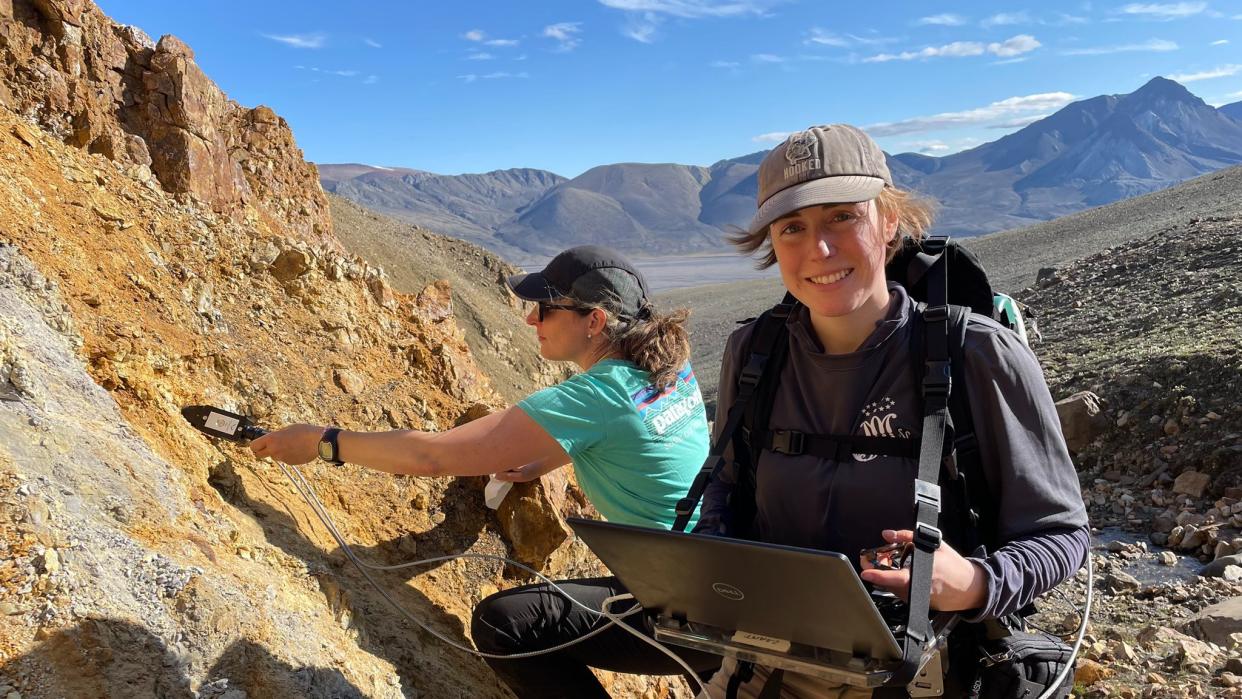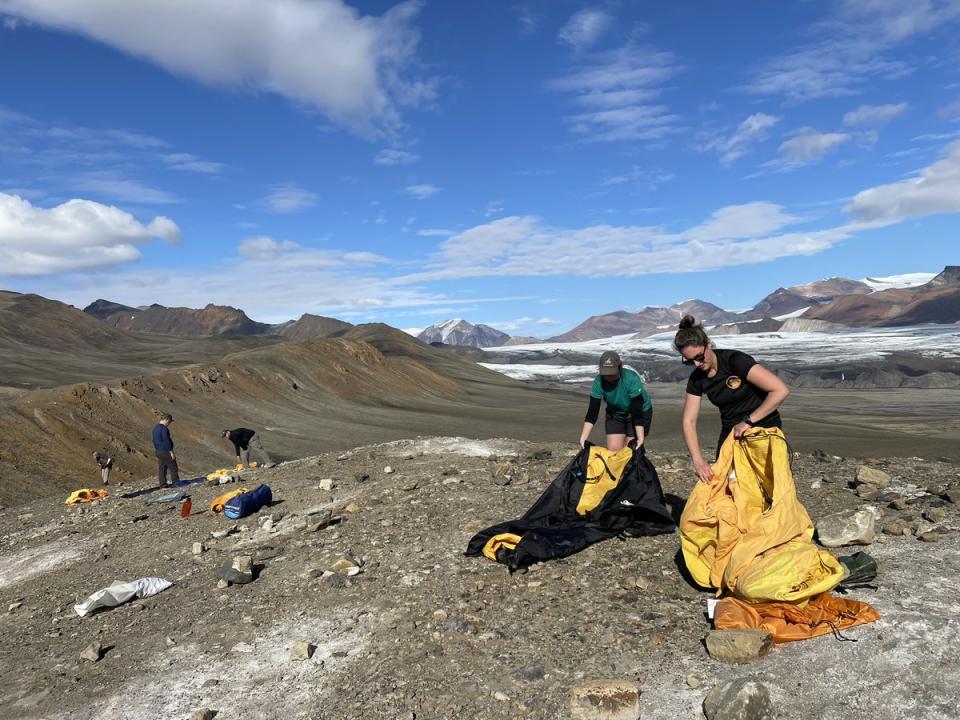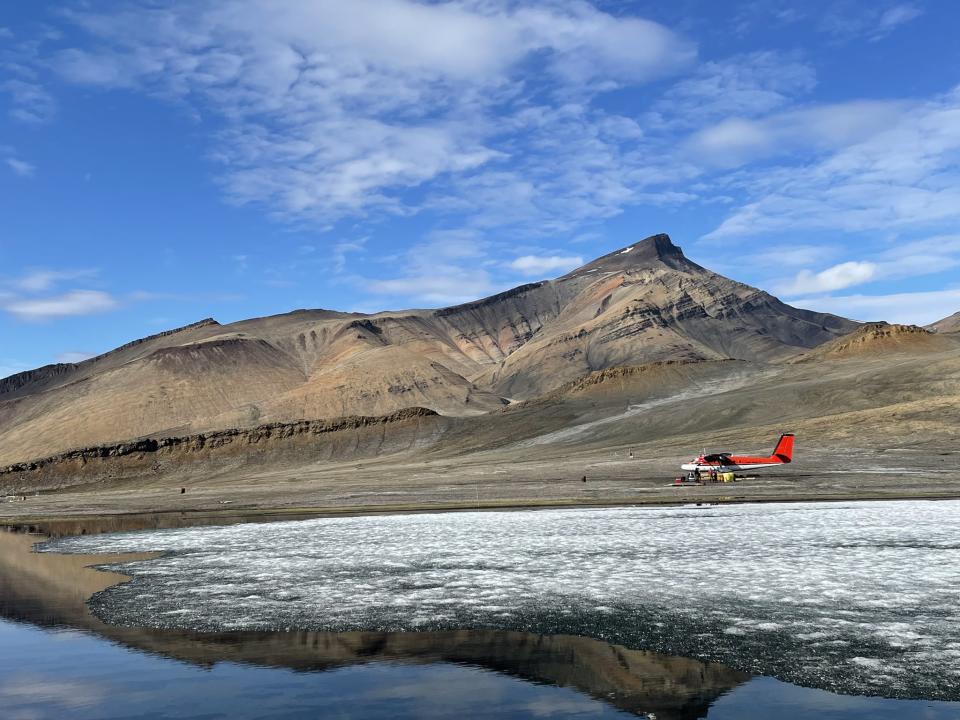Rusty Arctic rocks could help us understand water on Mars (photos)

Researchers are on a hunt for Mars-like rocks high in Canada's Arctic.
The T-MARS project (also known as Terrestrial Mineral Analysis by Remote Sensing) is an expedition testing space living on Axel Heiberg, in the Arctic Ocean. Like ancient Mars, the remote island in traditional Inuit territory is a cold spot that still allows for liquid water at times of the year.
The running water and cold conditions makes the location perfect for T-MARS, a Canadian Space Agency-funded effort running until 2024. Numerous Canadian researchers are on site, including Arctic veteran and planetary scientist Cassandra Marion. "Once we get to the outcrop, we're collecting a bunch of samples. So on the way back, you're heavier, because you got a bunch of rocks on your back," Marion joked with Space.com by telephone, from Axel Heiberg.
Marion studies craters in remote areas and is also the science advisor at the Canada Aviation and Space Museum in Ottawa, Canada. If you want to hear from Marion personally, the museum is hosting Zoom calls with her on Wednesday, July 18 (in English) and Thursday, July 19 (in French), subject to weather. You can register here.
Related: Water on Mars: Exploration and evidence
As Colour Ridge narrows, the views of White Glacier and Thompson glacier get better and better. #gossans #AxelHeibergIsland #TMARS #awesomehike pic.twitter.com/MUmtwaiIIaJuly 16, 2023
Marion and her colleagues are on the hunt to understand gossans, which are highly eroded ore deposits that have analogies to Mars rocks.
"Gossans contain abundant alteration minerals, which require the presence of water during their formation," the T-MARS project website states. Similar minerals on Mars suggest "the presence of ancient hydrothermal systems on this planet, since the formation of these minerals requires water," the statement adds.
Using tools and science investigations, the team aims to better understand Martian geological processes, to find new techniques to search for signs of life and to experiment with space technologies (such as satellites) to assist with the ground expedition.
Related: Mars missions: A brief history
"It's really a remote sensing-based project," Marion said of T-MARS, which uses both satellite data from Worldview and on-site data from a small drone Marion pilots herself.
"Some of the students, their research is focused on identifying these deposits from the satellite, and then finding them on site. They're sampling, they're mapping them and they're evaluating if their interpretations from the satellite data are accurate."
One student is also test-driving a new processing technique to make the gossans stand out in the data, Marion noted. And T-MARS is not the only investigation examining gossans on Earth.
For example, scientists with the NASA Curiosity Mars rover examined biosignatures from a location known as Iron Mountain, near Los Angeles, "to assist with interpretation of mineral texture on Mars," a United States Geological Survey page about that study states.

This expedition is Marion's sixth to the high Arctic and 13th overall; she has also been to locations such as the Mars Society's Mars Desert Research Station near Hanksville, Utah that also does Red Planet-like work and research.
Going on this expedition requires months of training, Marion pointed out. All participants have remote first aid certification as the "bare minimum," while a few also have a firearm possession and acquisition license as a last-resort form of protection against wildlife. Training in riding helicopters, situational awareness and remote environments and wildlife protocols is also a necessity so that everyone knows how to behave and think before arriving.
Other requirements include physical fitness, as the expedition based near the McGill Arctic Research Station (yes, the McGill University facility's acronym stands for MARS) requires hours of hiking in rugged terrain, and carrying equipment. Just one of the instruments, a reflective spectrometer, has a mass of 40 pounds (18 kilograms). "The whole instrument has its own backpack, and it's the heaviest backpack," Marion said.

The techniques scientists are using on-site are not only useful for Mars, but also the moon. That's highly relevant given Canada is highly involved in moon exploration, alongside NASA, under the American-led Artemis Program aiming to land astronauts on the moon in 2025 or 2026 along with a suite of scientific payloads.
For example: Artemis 2 will send Orion the moon in November 2024 with NASA astronauts Reid Wiseman, Victor Glover and Christina Koch, along with Canadian Space Agency astronaut Jeremy Hansen. A Canadian micro-rover, a utility vehicle and experiments funded by the CSA's Lunar Exploration Accelerator Program are also bound for the surface, among many other activities.
RELATED STORIES:
— Mars' atmosphere: Facts about composition and climate
— Life on Mars: Exploration and evidence
— NASA's Artemis program: Everything you need to know
"The students that we're bringing up here, this is developing highly qualified people that you can use to work on those missions," Marion said. "These expeditions are really training the generation that is going to be interpreting all of the data coming back from the moon, which is going to be huge for both the rover and human missions."
Additionally, the head of science on the T-MARS mission is Myriam Lemelin, an assistant professor at the Université de Sherbrooke in Quebec. Lemelin is highly experienced in space missions and is part of three moon efforts alone: The lunar micro-rover, the NASA-led Volatiles Investigating Polar Exploration Rover (VIPER) water-hunting rover mission, and the lander-rover mission Lunar Vertex. All three are scheduled to touch down on the moon later in the 2020s.
The researchers will be on site until July 22, meaning they will also celebrate there the 54th anniversary of the Apollo 11 moon-landing mission on July 20. Data analysis and publications will also close out the rest of the project timeline in 2024.

